Coronavirus Takes Its Toll on Hospitality Industry
/At the Council’s December webinar and virtual annual meeting, Mary Holland, owner/operator of Hereford House Restaurants and Pierpont’s at Union Station, said her industry was already prepared for COVID-mandated quarantines, lockdowns and closures that heavily targeted restaurant and bar establishments. Additional sanitation requirements and stricter oversight are nothing new to her fellow restaurateurs. “Our industry is already held to high standards,” said Holland. Phil Strnad, general manager of the Hilton President Hotel for the last 13 years, reiterated, “People don’t understand how much we get inspected for cleanliness.” But Holland noted her dining rooms and kitchens upgraded their sanitation products and systems anyway.
For the most part, the pandemic has not made things easy for the hospitality industry. Jason Fulvi, president of Visit KC, reported some of the bleak statistics:
167 events were canceled this year representing 300,766 room nights of lost business.
Downtown room occupancy on March 11, 2020 was 71.5%; a week later, March 18, the occupancy rate was 8.8%.
But there was some good news. The rate had recovered somewhat to 22.5% over Thanksgiving and 45% of corporate travelers are considering resuming domestic business travel in the near future. Strnad said no one had any idea how bad the pandemic was going to be. He added, “We need to get people traveling and back into hotels again; get them comfortable.” The stakes for doing so are high for the regional tourism industry. Tourism has a $5.6 billion economic impact on the area annually. It supports 48,350 jobs. Kansas City hosts 25.2 million conventioneers and leisure visitors a year, and almost half (47%) stay overnight.
Fulvi suggested road trips and travel closer to home will likely drive much of the hospitality recovery as COVID-19 recedes. Surveys by 2020 MMGY Travel Intelligence indicate 68% of travelers feel safer in their own car; 45% are likely to travel by car after COVID-19; 43% will travel to destinations close to home. Trips of 300 miles one way appear to the preferred distance for Americans these days.


